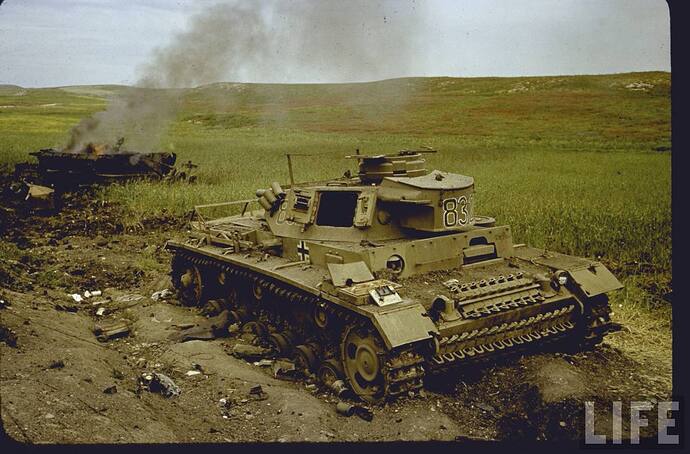You’re probably right. It would be better to keep the tank crews alive rather than comfortable!
I’m sorry, but couldn’t find a thread about PzKpfw IV.
This was posted on the pic site, and I was wondering what the framework below the gun was for. Anyone know?
Is a deflector for the radio antenna, if not the gun barrel would break it.
The topic:
http://www.ww2incolor.com/forum/showthread.php?t=4588&highlight=panzer+IV
Well crap, I put PzKpfw IV in search for threads and posts and nothing came up!:oops: Anyway, thanks for the info, looked kind of odd to have something hanging from the gun like that. And thanks for the thread link!
Ah…dont feel bad, the search tool is no good, unless you pic the option “search the title only” you would never find it.
Another weird variant, Panzer III with the infantry pak 38.

Panzer III ausf H.

Up armored variant introduced in january 1941, still fitted with the short gun.

Ausf H of the afrika Korps, note the aircraft claimed as destroyed painted in the side of the main gun.

Lucky shot, hitting an airplane with the main gun.
Yea, lucky, probably was hit in the ground.

You’re probably right. That would make it easy to take them down.
Perhaps they shot it down with the MG 34 that is used for AA defence, then painted the kill on the side of the gun as they would with all kills.
Paul
Is possible but not likely, the panzer IIIs deployed in Africa at that time ( 1941) rarely had a MG 34 mounted for AAA purposes.
Panzer III steel.
Some tables showing the armor alloy composition for a captured panzer III



Panzerbefehlswagen III
From the D variant up to the J panzer III was converted in specializated command tank. The preparation for thsi variant were made as early date as 1937, a clear indication the the germans colonels and Generals going to lead their troops from the front.
The changes included the removal of the coaxial MG 34/34s, and the adition of adiational more powerful radio equipment. The enigma machine was carried sometimes.

Lucky shot but it is possible. I read an account from an artilleryman whose M7 Priest was being strafed by a low level German plane and hit it with the 105mm main gun. The German pilot just happened to fly into the path of the shell. Incredibly lucky shot but possible none the less.
Possible but not likely.
Another image of the Commmand panzer III.

The Ausf J



Pzkpfw III in action- Bruce Culver
Panzer III varianst / W Spielberg.
3 photos of the Panzer III G with interleaved roadwheels suspension doing some test in the austrian-German border, winter 1942/43. The tank is testing an armored trolley for infantry transportation in snowy conditions.
I am not quite sure what are those atachments in the sides, in front of the turret.



This is very interesting to see whats in the German made armor, Chrome moly steel is really tough,lends itself well to rolling, and shape forging, but is a bit tricky to heat treat properly. I do agree that the alloying elements were in low proportions, and compensating by adding carbon will most likely produce brittle spots,perhaps causing uneven performance. Were the carbon any higher, it would have been more difficult to work hot(in high volume production).High amounts of carbon can allow a plate greater resistance to abrasive conditions, it may lessen somewhat the impact resistance to incoming projectiles.(Given a fairly thin section). (U.S. armor in the 70’s was 4140, or 4340, dont remember which just now, which is a chrome moly at .04% carbon. ) Hardness is a function of carbon content, and after one reaches about 1-1.3%, the metal can become no harder, but will continue to gain toughness.Thicker sections of plate, several inches, could contain greater amounts of carbon without loss of performance.If I heard correctly the description of the armor used on certain German Battleships, the carbon content may have been at, or near 2-2.5% The narrator referred to the steel as “Wooten” this may be actually “Wootz” steel, the modern name for Damascus steel. This is an ultra high carbon steel that is tough beyond the usual concept, and extremely strong, though working it can be tricky.For comaprison, a file is about 1.2% carbon, and a ball bearing about 1.5% carbon. I’m pulling this up from memory,(journeyman blacksmith tool maker) so Percentages given are approximated.
The narrator referred to the steel as “Wooten” this may be actually “Wootz” steel, the modern name for Damascus steel. This is an ultra high carbon steel that is tough beyond the usual concept, and extremely strong, though working it can be tricky.For comaprison, a file is about 1.2% carbon, and a ball bearing about 1.5% carbon. I’m pulling this up from memory,(journeyman blacksmith tool maker) so Percentages given are approximated.
Probably is “Wotan” wich was a steel brand of the Krupp firm, it was cemented steel.
I looked up “Wotan” steel, and it shares some characteristics with “Wootz” particularly in the cementite precipitation (Ferric Carbides) so Old Krupp must have figured out a way to make this great steel, or a relative of it, in quantity. Thats cool. This should not be confused with the type of steel used in making Japanese swords, or present day pattern welded steels used in knife making. That is a different material, even though it may look the same.

